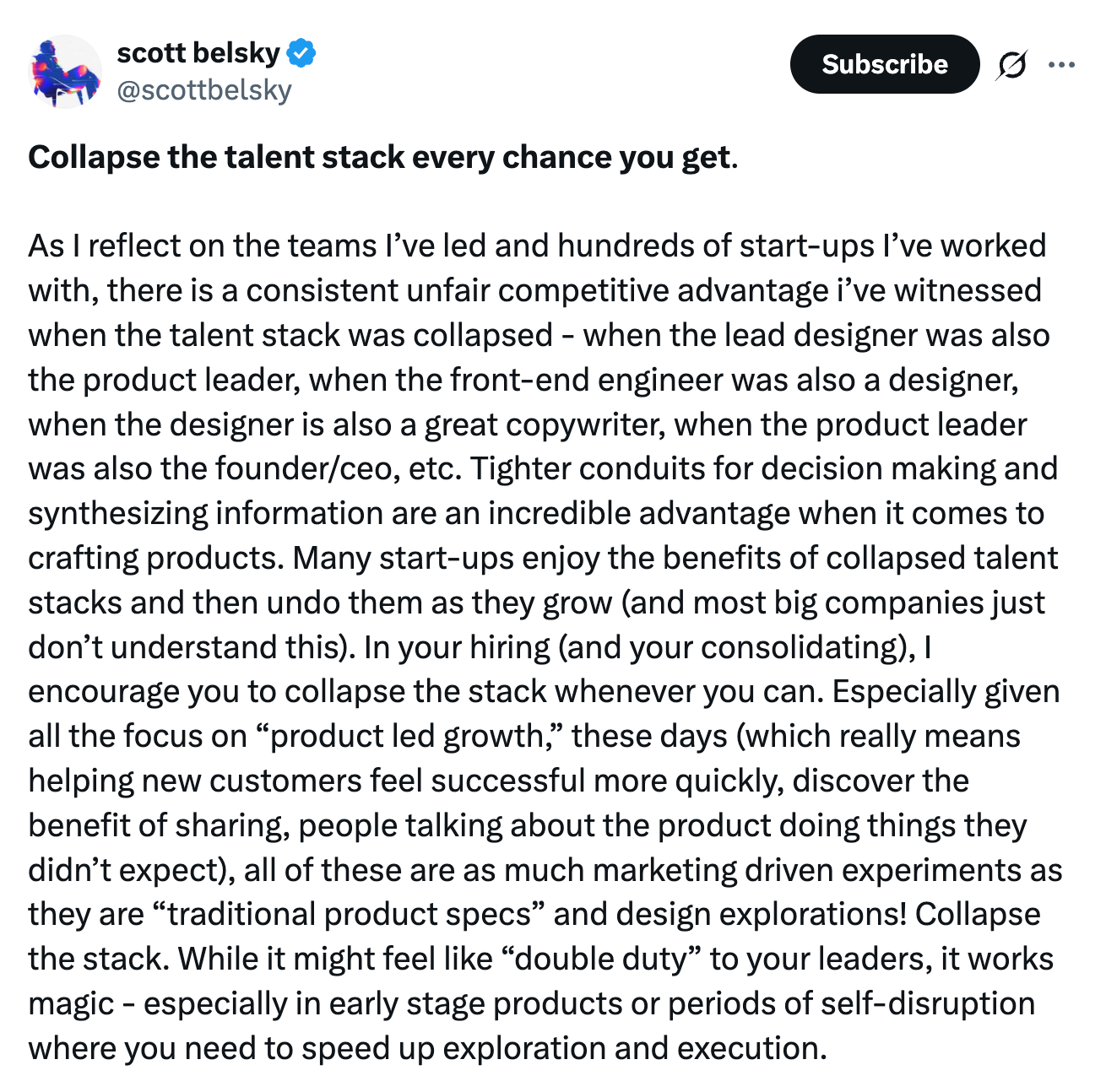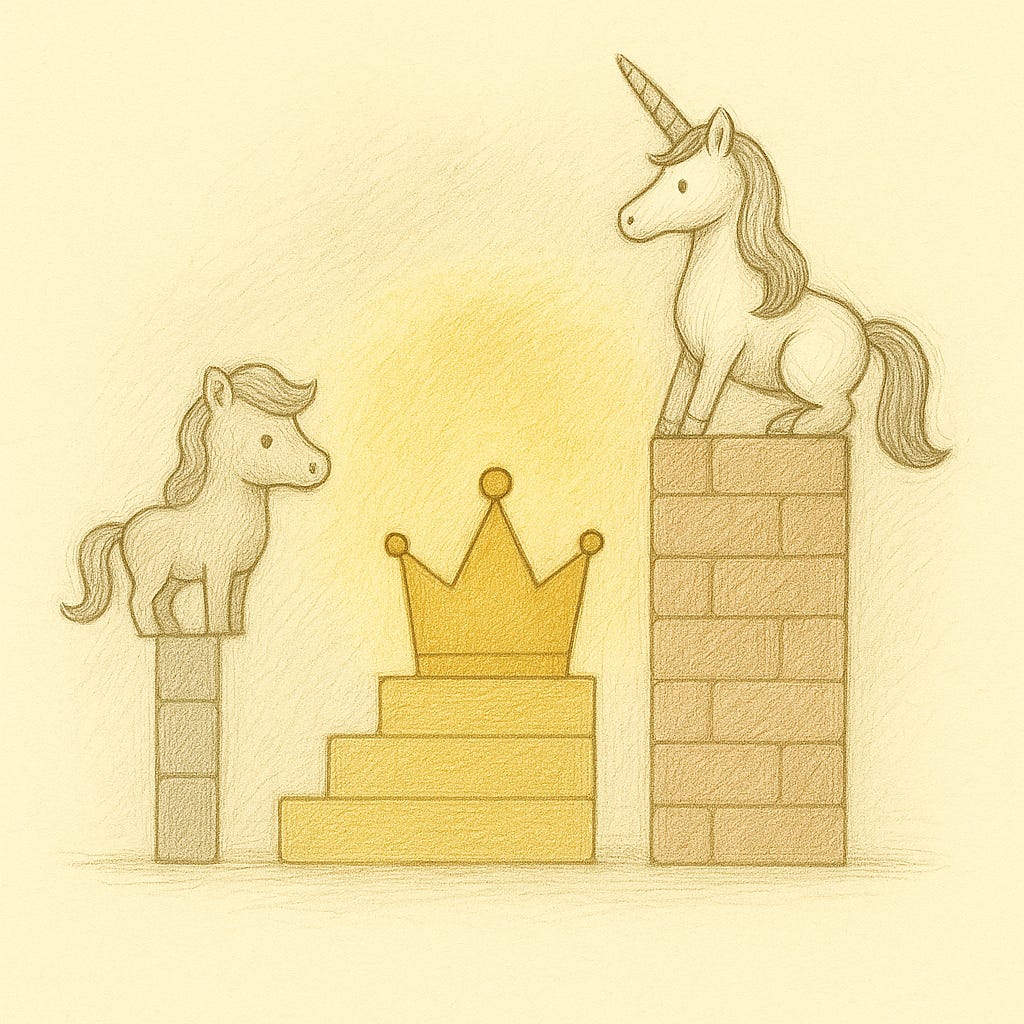A couple of years ago, at the early onset of the AI era that is now in full swing, I came across an insightful and provocative post from
on team-building: the idea of collapsing the talent stack -What stuck with me about this were 3 novel insights -
Blurring the lines can lead to superior syntheses and pattern-matching.
Collapsing the talent stack can drive faster product discovery and decision-making.
The amalgamation of distinct roles (ex: design <> product) positioned as an unfair advantage for teams that choose to do it.
In the last 12-18 months, the sense I get is that the combination of (i) a secular trend towards smaller product teams, (ii) heightened appetite for product innovation and (iii) the emergence of AI generative technology and productivity tools has put more scrutiny on the talent stack for typical product teams.
While many startups and smaller orgs are explicitly collapsing their talent stacks by prioritizing hybrid, multidisciplinary roles (ex: design-engineering), I am noticing even larger, more established companies are beginning to rethink traditional functions / functional ratios, consolidate roles when there is natural affinity (ex: Duolingo, Airbnb) and encourage their teams to color over the lines more (ex: when working on newer paradigms for AI products with no priors ex: prompt engineering, evals).
I would go so far as to say there is a kind of stratification underway between organizations that are leaning into new ways of blending or remixing functional expertise within teams - and those that are not. Undoubtedly, these talent stack experiments will come with growing pains, learnings and even some controversy. It will be fascinating to see how it all shakes out. And as these things tend to go, we should expect to see these trends spread broadly across more organizations, after the early movers show us all what works and what doesn’t. Things are in motion!
The emergence of “M-shaped” talent
In recent months, I have been reflecting quite a bit about the ideal talent profile for product folks working on 0-to-1 products, and have had many conversations on this with folks in my network too. In one such recent conversation, we talked about the unique value of product people who are “M-shaped” in their skillsets and profiles. To clarify that - in contrast with the more familiar “T-shaped” profile, M-shaped talent demonstrates rich expertise and skills across multiple, distinct domains or functions. Imagine: a PM with a researcher background, a Designer with brand marketing expertise, an Engineer who is a part-time artist, and so on. For teams working on innovation initiatives or new products, M-shaped product folks are often best positioned to navigate the bumpy 0-to-1 (to 10, if they’re lucky!) journey of bringing a new product to life.
M-shaped talent can be rare finds. Their multidisciplinary expertise often comes from a unique, distinctive collective of life and professional experiences and non-traditional career paths. Their resumes are far less “cookie cutter” than most others, which is both a blessing, and can be a curse too (ex: when hiring teams struggle to pattern match them). But when they are aligned to the right role, team and opportunity - they can often bring impact to the table that is magical and irreplaceable. This is because their personal talent stack is both richer and fuller than most of their peers.
Zooming out. To me, the unique value of M-shaped talent goes beyond 0-to-1 product teams. And this may be more true now than ever before, given the following patterns -
Product teams are getting smaller and leaner
The barrier to building and shipping new products/features is getting lower
AI tools are supercharging our ability to co-create and collaborate - while blurring the lines between functions
If these trends hold, we may see a major evolution in how product teams are constructed and how they operate. Today, product teams often act like tribes bound together through common values and goals, but comprised of focused specialists that are responsible for specific duties that the tribe relies on them for - farmers, soldiers, wise elders, etc. In the future, we may see product teams act more like guilds of polymaths - folks who are connected by a shared mission and ambition, but are able to overlap, swarm and co-create more seamlessly, given their well-rounded skillsets (extended with the benefit of AI).
To me, the implication of this is that it is likely that M-shaped talent will be seen less as rarified or raw in nature, like today. They will be seen as most valuable, and required for a world-class product team. Thus, as more organizations look to collapse their talent stacks, we can seek to construct our own rich talent stacks - and thrive.
Constructing a personal talent stack
We must approach constructing our personal talent stacks from a new lens, not the common specialist vs. generalist frame. That framing nudges us to pick between two imperfect options - to either be a one-trick pony or a jack-of-all-trades, master-of-none. And any genuine desire/aptitude to develop mastery over multiple disciplines is often seen as fantastical or impossible - as if we want to become unicorns! A more fulfilling opportunity may lie somewhere between being ponies or unicorns. It is to build our talent stack upwards, one layer at a time, on top of our core expertise.
Many of us begin our careers with a singular focus in one discipline. It is often a discipline that speaks to us on a personal level, one that we aspire to build mastery and expertise in. If you are a PM, your core may be around deep product sense. If you are a Designer, your core may be around visual or interface design. And so on.
As we develop that core expertise, we have the option to intentionally build up our talent stack from there, by expanding our purview into newer disciplines. For PMs, this may be about developing skills at research or product marketing or sales. For Designers, this may be about developing expertise in coding or team leadership. And so on. It’s possible we never attain the degree of mastery here as in our core expertise, or that it takes us longer to develop a new expertise area That is expected and ok, as long as we are effectively moving “up the stack”, one step at a time.
Importantly, the intent behind constructing a personal talent stack like this is not simply to augment your skills within your core expertise area (ex: a PM developing business sense or analytical skills). It is to layer on distinct and complementary expertise on top of your core over time. It is about constructing a new, bespoke, M-shaped talent profile for yourself that makes you stand out, uniquely. And it is about ensuring that one day, when you are part of your next guild of polymaths, you are the best contributor and leader you can possibly be!
If you liked this essay, you may also like Of 10x Engineers and 1/10th Teams, written by my friend
, who touched on some similar themes.You can browse all of my past essays at https://waqas-sheikh.com/
If you know a friend or colleague who may benefit from Waqas’ Musings, please share with them using the button below -






While I love the vision of product teams as “guilds of polymaths”, the current reality was shaped only in part by best practice. The modern firm builds its edifice on rigid structures. For this kind of product team to come to exist, we’ll need far more fluid operation across an organization, from RnD to Ops to Human Resources.
It's universally acknowledged that the current approach to hiring candidates is totally broken, between AI-generated resumes and AI-augmented interviews. There's a wonderful opportunity to rethink how we build teams and talent from the ground up. But it's a massive challenge, and only the most flexible of organizations will be able to meet it.
This flexibility might be the real advantage of the current generation of startups. I'd love to see more established companies rise to the occasion!